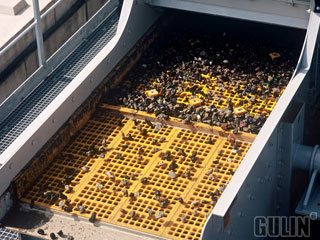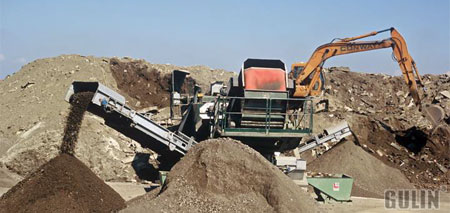
Aggregate Concrete Washing Plant
The aggregate washing plant can process up to 100 tonnes of aggregate per hour, though it normally handles about 55 tonnes per hour. In total, about 100,000 tonnes of aggregate are processed per year. The system uses high pressure water jets to loosen the fine particles from the coarse aggregate. It is directly linked to the nearby Drainage Treatment Plant which supplies almost all of its clean water. Used wash water is transferred to the Drainage Treatment Plant via a series of underground pipes to be thoroughly cleaned and returned to the washing plant for the process to be repeated. The plant uses 55m3 per hour of clean water, nearly all of which is obtained from the Drainage Treatment Plant. This is estimated to save the use of 24 million gallons of mains water per annum.
The washed aggregate is screened into four European Standard grades:1) 0/1mm; 2) 0/4mm; 3) 4/20mm; 4) 20/30mm.
These are used for concrete production and a variety of unbound applications.
Concrete Making Process
Material from all sources is inspected visually on the weighbridge as it enters the site by a series of remote cameras, to ensure it is of adequate quality. Material from external sources is carefully screened to ensure it is only concrete or asphalt, with no brick or soil. Approximately 150,000 tonnes of material are processed per annum. Concrete and asphalt are kept in separate stockpiles.
Crushing and Screening
The initial process for all materials except the gully waste is crushing and screening to produce a well graded material conforming to Type 1 unbound subbase mixture in the Specification for Highway Works. The crusher can handle blocks up to 1.0m3 in size and can process up to 350 tonnes of material per hour. The crushed material is screened at 30mm, and oversize material is put back through the crusher so that it is all used. Some of the

Drainage treatment plant
Drainage waste is taken directly to the Drainage Treatment Plant, which has capacity to treat up to 30,000 tonnes of waste per year. It is estimated that the plant has capacity to treat all the gully waste south of the Thames plus the arisings from Kent, Sussex and Surrey. The plant is currently going through the Integrated Pollution Prevention and Control (IPPC) authorisation process, which should be complete by June 2005.
The plant works via a complex system of washing, grit classification, screening, dissolved air flotation and dewatering. The system is computer controlled and uses state-of-the-art water treatment technology. The plant is enclosed in a purpose-built steel frame building and the surrounding area is bunded and graded so that all rainwater and any spillages are captured and used in the plant. The site is located in an old gravel pit, and great care is taken to protect the underlying aquifer. Initially a wash drum separates any material coarser than 10 mm and washes clear any oil and organics. Particle sizes less than 10 mm are conveyed to the grit classifier where any remaining organics and volatiles are removed, rendering the resultant sand and gravel clean and suitable for use as aggregate. Floating solids such as plastic or litter are removed by a fine screen. The remaining suspension is dosed with flocculants and dissolved air to remove the hydrocarbons and very fine silt. The remaining sludge is dewatered via a series of belt presses to produce a semi-dry silt cake material. Potentially 95% of the input materials can be reused. The outputs show considerable seasonal variation, as shown in Table 1 below.
Specification of Aggregate Concrete Washing Plant
| Models | LSX-920 | 2LSX-920 | LSX-1120 | 2LSX-1120 |
|---|---|---|---|---|
| Number of spiral | 1 | 2 | 1 | 2 |
| Diameter of screw (mm) | 920 | 920 | 1120 | 1120 |
| Length of tub (mm) | 7585 | 7585 | 9750 | 9750 |
| Feed Size (mm) | ≤10 | ≤10 | ≤10 | ≤10 |
| Capacity (t/h) | 100 | 200 | 175 | 350 |
| Speed of screw (r/min) | 21 | 21 | 17 | 17 |
| Electric Motor Power(kW) | 11 | 2×11 | 18.5 | 2×18.5 |
| Water Consumption (t/h) | 10-80 | 20-160 | 20-150 | 40-300 |
| Dimension (mm)(L×B×H) | 8420× 2180 ×3960 | 8420× 3970 ×3960 | 10770× 3950 ×4860 | 10770× 5260 ×4860 |
| Weight (t) | 6.2 | 11.5 | 10.9 | 17.8 |

